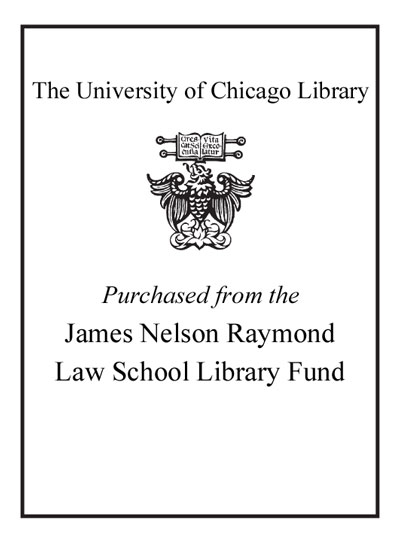Criminal law and the man problem /
Saved in:
| Author / Creator: | Naffine, Ngaire, author. |
|---|---|
| Imprint: | Oxford : Hart Publishing, 2019. ©2019 |
| Description: | xiii, 205 pages ; 24 cm |
| Language: | English |
| Subject: | |
| Format: | Print Book |
| URL for this record: | http://pi.lib.uchicago.edu/1001/cat/bib/11881213 |
Table of Contents:
- Acknowledgements
- Introduction
- 1. The Problem Illustrated: The Landmark Marital Rape Case of DPP v Morgan and Its Mixed Significance for the Men of Law
- I. Introducing the Men of Legal Influence: The Cast of Characters
- II. The View from the Bench and the Man of Law as Judge: Lord Hailsham of St Marylebone and DPP v Morgan
- III. The Textbook Writer as Husband
- IV. Eyes Wide Shut
- V. The Doctrinal Scholar and Selective Attention: Morgan as the Focus of Discussion About the Mental State of Serious Crime
- VI. The Legal Scholar as Political Philosopher
- VII. Rape as the Acid Test
- VIII. The Developing Argument: Men are Critical to Criminal Law but Very Hard to See
- 2. Introducing the Criminal Legal World of Men: The Importance of Personal Border Control
- I. The Abstracted World of Criminal Law: 'There's Nobody Here but Us Persons'
- II. The Human Comes Ready-made: And the Law is Not Responsible for its Persons
- III. Introducing Men and the Male Story of Criminal Law and its World
- IV. The Don't-Touch Rule in the Offences against the Person: Who it is For and What it Presumes about its Persons
- V. The Don't-Touch Person: Men making Men in their Own Image as Self Proprietors
- VI. Questioning the Idea of the Self-Owning and Bordered Man
- VII. Jennifer Nedelsky and the Bounded Self
- 3. Hale, Blackstone and the Character of Men
- I. Sir Matthew Hale (3609-1676)
- II. William Blackstone (1723-1780)
- III. Edward Christian and the Footnote
- 4. JS Mill, Stephen and the Victorian Mentality
- I. Baronet James Fitzjames Stephen (1829-1894)
- II. The Provocateur: John Stuart Mill and the Husband as Critic of Men and Marriage
- III. Stephens Dissent from Mill
- IV. R v Clarence
- 5. The Cast of Men: The Bounded Man, the Domestic Monarch and the Sexual Master
- I. The Male Body Politic and the Masterful Man
- II. The Woman Problem
- III. The Husband as Little Monarch
- IV. The Sexual Master
- V. The Nursery of the Vices
- 6. From Male Supremacy to Sexual Euphemism: Good Men Trapped in their Own Assumptions
- I. The Men of Law Recede from View: The Resort to Euphemism
- II. Glanville Williams (1911-1997)
- III. Norval Morris (1923-2004)
- IV. Rollin M Perkins (1889-1993)
- V. Colin Howard (1928-2011)
- VI. Tony Honoré (1921-)
- VII. The Mature Glanville Williams Textbook of Criminal Law
- VIII. Disdain for Women
- IX. The Attitudes of Ordinary Men and Women of the Time
- X. Reflections on the Men of Law and the Shifting Ground
- 7. The Modernisation of Men, Or Men Assuming Responsibility without Taking Responsibility
- I. The Committees that Modernised Men in the Law of Rape
- II. The Judiciary on (Male) Modernisation: Cherchez la Femme
- III. Assuming Responsibility
- IV. Historical Revisionism and Denial of the Past
- V. Concluding Thoughts
- 8. The Invisible Men: Why the Men of Law Cannot See the Men of Law
- I. The Knower and the Known
- II. The Disappearing Expert
- III. Modern Criminal Law Scholars Adopting the Olympian Stance
- IV. The Problems of the Olympian Stance
- V. Fudging the Past and Cognitive Dissonance
- VI. The Closed Community of Thinkers
- VII. Power and Inattention
- VIII. Disqualification of the Naysayers: Excluding Women as Experts and Epistemic Injustice
- IX. Acknowledging the Past: Recognising the Scale of the Problem
- 9. The Modern Individual of Criminal Law
- I. The Abstracted Individual
- II. The Responsible Individual Defendant as Rational Agent and the Disappearing Man
- III. The Critical Legal Moment of Decision-Making
- IV. The Choice of the Choice-Maker: To Rape or Not to Rape, that is the Question
- V. Is this Legal Deconstruction of such an Unpleasant and Unsavoury Decision Implausible? Is this Really How Criminal Lawyers Think?
- VI. The Legal Individual as a Physical Being (Without a Sex)
- VII. And the Deeming of Women
- VIII. Abstraction and the Disappearing Man
- 10. Men, Women and Civil Society: Male Civility in the Twenty-first Century
- I. The Zeitgeist
- II. Recognising the Man Problem in the Special Part of Criminal Law
- III. Recognising the Man Problem in the General Part of Criminal Law
- IV. The Abstraction of the Person and the Problem of Bad (Male) Pedigree
- V. What has Happened to the Bounded Individual, the Little Monarch and the Sexual Master?
- VI. Persons as Relations
- VII. Effecting Change
- VIII. Studying Men as a Specific Sex and as a Sectional Interest
- IX. Maintaining Moral Coherence and Avoiding Cognitive Dissonance
- X. Willingness to Attack One's Own Convictions
- XI. Going Further: Effecting Fundamental Change; Kuhn and the Paradigm Shift
- Recapitulation
- Bibliography
- Index

